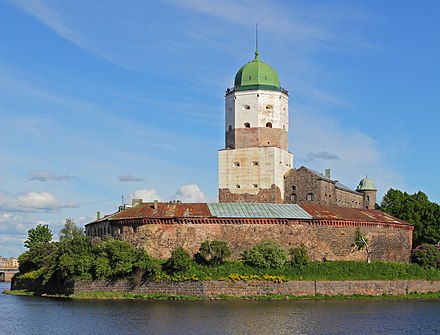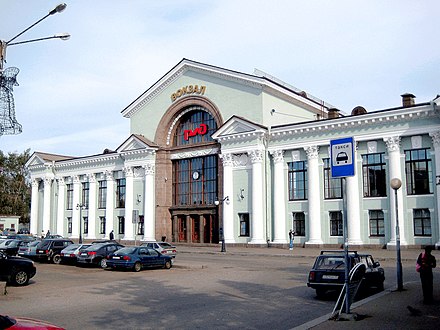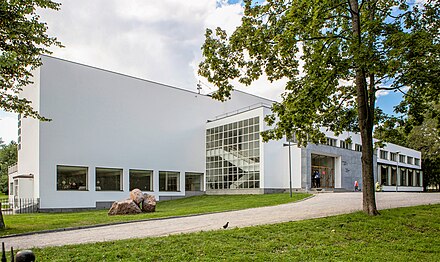Vyborg - city in Leningrad Oblast, Russia
 Vyborg (Russian: Вы́борг; Finnish: Viipuri; Swedish: Viborg) is a city in Leningrad Oblast, Russia, near the Finnish border. It was Finland's second-largest city until World War II, when it was handed to the Soviets as war reparations. It is part of the Silver Ring of cultural and historical centers of Northwestern Russia.
Vyborg (Russian: Вы́борг; Finnish: Viipuri; Swedish: Viborg) is a city in Leningrad Oblast, Russia, near the Finnish border. It was Finland's second-largest city until World War II, when it was handed to the Soviets as war reparations. It is part of the Silver Ring of cultural and historical centers of Northwestern Russia.
Understand
The city is at the mouth of the Saimaa Canal, on a bay of the Gulf of Finland. Until World War II it was an important trading city. Especially in the 19th century it had a very international atmosphere. Although the Finnish speaking population grew from half to more than ninety percent, multiculturalism was important to the identity of the city, and the minorities of Swedes, Germans, Russians, Romani, Tatars, and Jews remained.
At the end of World War II the former population was evacuated and the city was later populated by Soviet Union citizens. The pre-war population of 70,000 was reached in the 1970s, with Vyborg having some 80,000 inhabitants in 2010.
History
Vyborg was one of six charted towns in medieval Finland. It started out as a marketplace for Karelians, belonging to the Novgorod realm. Until the 17th century Vuoksen, draining much of the Finnish Lakeland, had a western mouth here, while the eastern mouth was (and remains) in Ladoga. Thus Vuoksen connected Vyborg with Saimaa on one hand and Ladoga on the other, while Vyborg itself was on the coast.
Vyborg was conquered by Sweden in the "Crusades", and a fortress of stone was built in 1293, in place of the former wooden one. The town got its charter in 1403 and became one of the most important towns in the eastern part of Sweden (which was to become Finland).
Ceded to Russia in 1720 it grew in importance as a trade route for the Karelians, to the new Russian capital Saint Petersburg. This position remained when it became part of the Russian Grand Duchy of Finland in 1812.
Again part of Finland, Vyborg was one of the grand duchy's most important cities. The Saimaa Canal, inaugurated in 1856, again provided access to the Finnish Lakeland. Vyborg remained one of the most important cities in independent Finland until World War II, when it was ceded to the Soviet Union, reconquered by both sides and finally became Russian once more. There is much nostalgia for the city in Finland, which can be seen in the museums, with many Finnish visitors.
Get in
The Russian war on Ukraine has shut down many of the connections from Finland. Check current situation.
Seeing Vyborg is possible as a day trip from or Lappeenranta, or as a stopover on the Helsinki– train line. From Finland you need a visa, except on some organised cruises.
By plane
Saint Petersburg has good plane connections.
By bus
- Bus excursions depart St. Petersburg's Gostinyy Dvor on weekend mornings and cost about , returning to St. Petersburg in the evening, a total of about 10–11 hours.
- International coach lines connect Vyborg to Helsinki, Turku, Lappeenranta and Jyväskylä in Finland. More information from Matkahuolto (dead link: January 2023), Savonlinja, Ecolines, Busvbg and Northpalmira.
By train

Trains from St. Petersburg use the Finlandskiy station; then there's also the overnight Moscow-Helsinki Tolstoy train from Moscow and Tver going via St. Petersburg Ladozhsky. Check the website of the Russian railway operator RZD for up-to-date timetables.
- The major international trains between Russia and Helsinki were suspended in 2020 due to the COVID-19 and again in 2022 because of the war Russia launched on Ukraine.
- Express trains (with upholstered seats and a restaurant car) run between 5 and 10 times per day, and take around 1¼ hr. Tickets cost each way, and tickets can be purchased in advance or at windows 27–30 at the station (not in the main hall) on the day of departure. Beware of long lines if you're attempting to purchase tickets shortly before the train departs.
- Elektrichkas (with wooden bench-seats and few amenities) run more or less as often as express trains, but take 2¼ hr. Tickets are slightly cheaper for a longer ride and can be purchased in the main hall at Finlandskiy station on the day of travel only.
Vyborg railway station, 60.715456°, 28.751311°. 2019-11-24
By small cruiseliner
In the summer there are daily cruises from Lappeenranta in Finland down the Saimaa Canal to Vyborg operated by Saimaa Travel (dead link: January 2023). If you are arriving and leaving Russia by ship from the same port and staying less than 72 hours you do not need a visa.
By yacht
See also: Saimaa Canal
You can make the same journey by small craft. As the town lies in the Vyborg Bay of Gulf of Finland, it is easily reachable by small craft also from the sea. With small craft you need visa and certain documents; check requirements in advance and follow procedures strictly. Coming from Finland (or the Schengen in general) you need to visit customs also on exit, before entering Russia. The Finnish customs on the inner fairway is at Santio near the border, the nearest customs by the open sea is on the island Haapasaari off Kotka.
By car
Vyborg is on the highway between and the Finnish border and you can visit the city if you are driving by.
Get around
Vyborg is compact and walkable. Local buses are available. Those in a hurry can take local bus #12 from the train station to the castle. City maps of Vyborg can be purchased at bookstores in St. Petersburg, at news kiosks at the Vyborg train station, and are sometimes sold at the Vyborg market ("rynok").
See
 A walking tour of the major sights of the city can be done in about three to four hours, with Vyborg Castle 📍 being the highlight of the tour.
A walking tour of the major sights of the city can be done in about three to four hours, with Vyborg Castle 📍 being the highlight of the tour.
From the train station, walk down Leningradskiy Prospekt and turn right along the embankment of the Salakka-Lakhti Inlet. See the Market Square 📍 on the left at the end of the quay, where one can see the Market Hall or "Rynok" and the 16th-century Round Tower 📍. Walk past the Round Tower to the Lutheran Peter and Paul Cathedral 📍 in the park. Cross the street to see the blue-painted Transfiguration Cathedral 📍, then walk up Vyborgskaya Ulitsa past the Council House Tower 📍 along the remnants of the old city wall, then head up the street (this is the least picturesque part of the walk through the Stone City) to see the Clock Tower tucked in among the apartment buildings. Before the Castle Bridge, see the Statue of Torgils Knutsson, the Swedish knight who founded the city in the 13th century. Look across the gulf to the Statue of Peter the Great in the park opposite.

Cross the bridge to Vyborg Castle which was built in 1293 by Swedes, captured by Peter the Great in the 18th century, served as a Finnish prison in the 19th century, and passed between the hands of the Soviets and Finns multiple times during World War II. The castle has several different exhibits, each with its own entry fee, and one can climb to the top of the tower for a nice view of the city. (Tickets for the tower cost from the museum cashier.)

Cross back over the bridge and walk up Krepostnaya Ulitsa through the town, turn left on Suvorovskiy Prospekt, see the Alvar Aalto Library 📍 and the Statue of a Moose in the park, then proceed to Red square 📍 and the Statue of Lenin 📍 before heading up Vokzalnaya Ulitsa back to the train station.
The Monrepos is one of the objects of Finnish nostalgia, an extensive English landscape park, founded in the 1760s. Under Soviet and later Russian rule much has been neglected or destroyed, but there have also been restoration efforts. Also, in the south-eastern part of the center of Vyborg is the another park, the East Vyborg Fortress 📍 (also known as Patterinmäki in Finnish), which is an old military and fortification area. The top of the rocky hill rises about 30 meters above sea level.
Do
- Gorodskoy Beach (Городской пляж), 60.710078°, 28.724531°. _2022-02-08_A popular beach located on the shores of Vyborg Bay.
Buy
 Visit the market hall ("Rynok") and the market square outside, where one can find Karelian knits and woolen clothing, as well as tablecloths and lace among the fruits, vegetables, shoes, and other sundry items. There is a public toilet available in the market, but it is very basic indeed.
Visit the market hall ("Rynok") and the market square outside, where one can find Karelian knits and woolen clothing, as well as tablecloths and lace among the fruits, vegetables, shoes, and other sundry items. There is a public toilet available in the market, but it is very basic indeed.
- Rynok (Центральный рынок), 60.71389°, 28.73769°. 2015-04-27
- Karusel (Карусель), Gospital'naya Ulitsa, 1, 60.719896°, 28.714416°, +7 812 448-30-10, claim@karusel.ru. A hypermarket. 2022-02-08
Eat
- Slavyanskaya Trapeza (Славянская Трапеза), Ulitsa Yuzhnyy Val, 4/2 (Just across the bridge from Vyborg Castle, in the buildings basement), 60.713574°, 28.729534°, +7 813 789-32-99. Serves moderately-priced Russian food, including excellent Chicken Kiev for about . 2018-03-16
- U Borkharda (У Борхарда), Ulitsa Podgornaya, 10, 60.714050°, 28.731494°, +7 931 336-63-63. Quite an extensive menu, including an excellent solyanka. Moderate to high prices in this rustic restaurant with kitsch decorations. 2018-03-16
- Restaurant NiKa at the Hotel Atlantik (Ul. Podgornaya 9). Prices are moderate to high.
- Kruglaya Bashnya, a Russian restaurant inside the Round Tower. Not as expensive as you might expect for its prime location, but service is slow.
Drink
- Pub Champion (Пивной Ресторан), Prospekt Lenina, 18, 60.710470°, 28.747093°, +7 813 782-02-47, champion.vbg@gmail.com. 2022-02-07
- Creep Pub (Крип Паб), Moskovskiy Prospekt, 9, 60.706642°, 28.749504°, +7 813 782-22-08. 2022-02-07
Sleep
- Hotel Atlantik, ul. Podgornaya 9 (close to the castle off a main street), 60.713928°, 28.73201°, +7 81378 2-47-76. Quiet, clean mid-range hotel with friendly and young English speaking staff. Breakfast included.
- Letuchaya Mysh Hotel (Bat Hotel), ul. Nikolaeva 3 (between Park Lenina and the Salakka-Lakhti Inlet), 60.712414°, 28.744016°, +7 81378 3-45-37. Known as "Letuchaya Mysh" in Russian is a mid-range hotel in the same class as the Atlantik.
- Druzhba Hotel, ul. Zheleznodorozhnaya 5, 60.715851°, 28.74583°. Imposing pyramid structure on the inlet.
- Northern Crown Hotel, Sbornaya Ulitsa, 2, 60.70475°, 28.76688°, +7 911 007-36-29, reservation@skhotel.ru.
- Fregat, г. Выборг, 30 корп.8, Kazarmennaya Ulitsa, 60.730056°, 28.683747°, +7 911 927-19-00, fregatvyborg@gmail.com. A hostel located in the small peninsula.
Stay safe
Connect
Cope
Go next
Vyborg
city.vbg.ruPostal code:188800–188811Date Time:Please wait...Timezone:Europe/MoscowPopulation:77,400Coordinates:60.71, 28.75
Leningrad Oblast
Primary administrative division